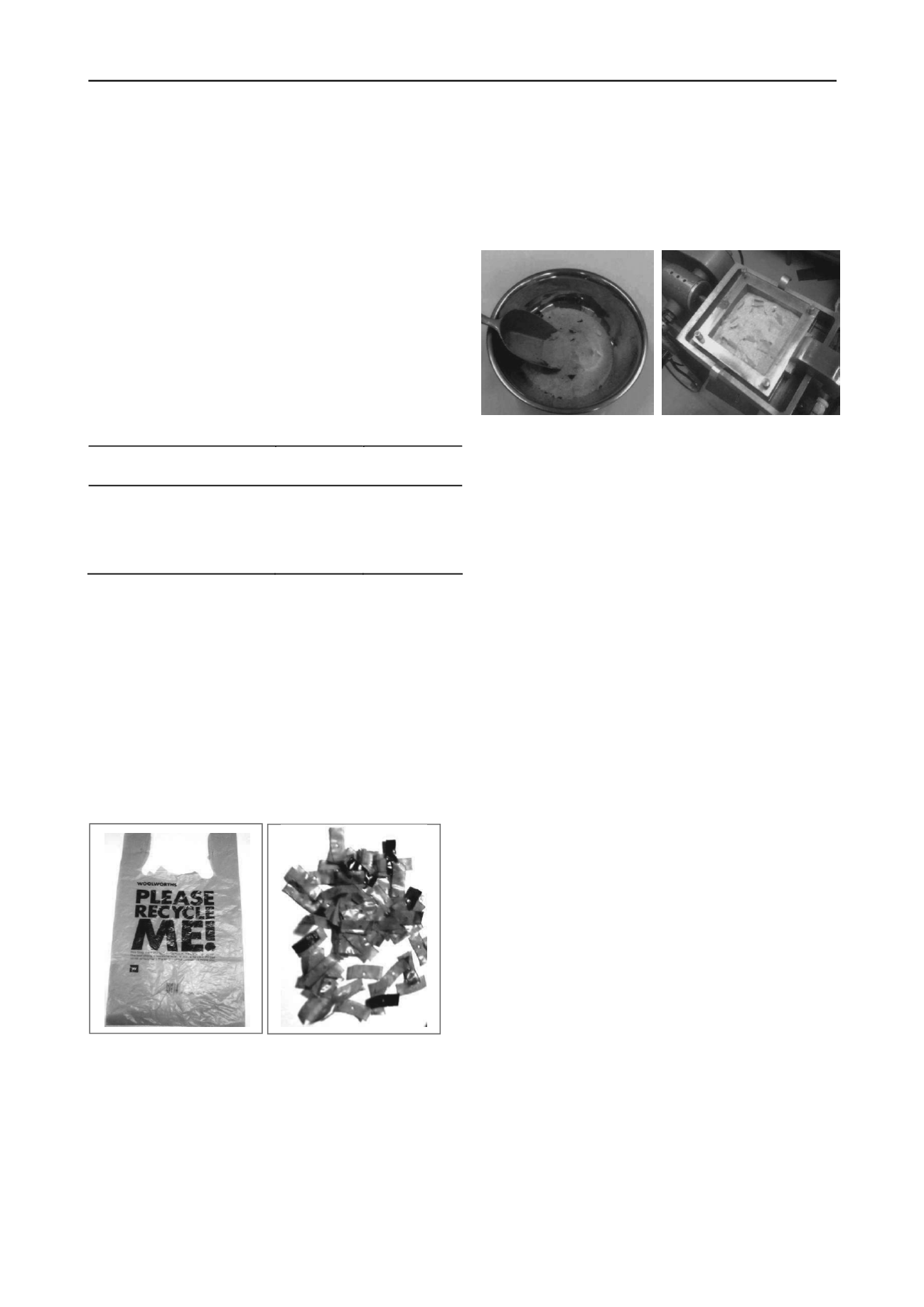
3224
Proceedings of the 18
th
International Conference on Soil Mechanics and Geotechnical Engineering, Paris 2013
bags on the shear strength of two locally sourced sandy soils.
Additionally, perforations were introduced on selected strips to
examine if increased bonding and interlocking of soil in the
soil-plastic composite through the openings in the plastic
material provided an additional effect on the shear strength
parameters of the soil-plastic composite.
2 MATERIALS AND METHODS
2.1
Soil Material
The soil types used in the study were Cape Flats sand and
Klipheuwel sand, both predominant in the region of Cape
Town, South Africa. Cape Flats sand is a medium dense, light
grey, clean quartz sand with round shaped particles while
Klipheuwel sand is a medium dense, reddish brown sand with
angular particles. Table 1 gives a summary of the physical
properties of the sands.
Table 1. Engineering properties of the selected soils.
2.2
Plastic Material
The plastic bags (Figure 1a) were sourced from a local
supermarket and shredded into strips of varying lengths and
widths using a laser cutting machine. The bags were labeled as
high density polyethylene (HDPE) according to the plastics
identification code by the American Society of the Plastics
Industry (SPI). The density was measured as 743 kg/m
3
with an
average thickness of 40
μ
m and a tensile modulus of 389.7
MPa. The tensile strength obtained for the plastic material
varied between 15 MPa and 20 MPa. Both the solid strips and
perforated strips were included in the testing regime. For
perforated strips, the laser cutting machine was used to make
perforations of different diameters on the strips (Figure 1b).
Figure 1: a) Plastic Bag
b) Shredded and perforated strips
2.3
Experimental Work
Soil samples for the tests were oven dried in order to eliminate
any effects of moisture and the plastic strips mixed with the soil
in a bowl to form a composite (Figure 2a). The plastic strips
used were of lengths 15 mm, 30 mm, 45 mm, and widths of 6
mm, 12 mm, 18 mm. Perforations of diameter 1 mm and 2 mm
were made on strips of width 6mm while their lengths varied.
The strips were added to the soil at concentrations of 0.1% 0.2%
and 0.3% by weight and the composite material placed into a
100 mm x 100 mm shear box for direct shear testing (Figure
2b). The specimen in the shear box was compacted to an
average density of 1700 kg/m
3
and the tests performed for
normal stresses of 25 kPa, 50 kPa, 100 kPa at a shear loading
rate of 1.2 mm/min. The peak stress for each soil specimen was
noted including the results obtained for the control experiment
in which no strips were added to the soil.
Figure 2: a) Soil-plastic composite b) Composite specimen placed in
shear box for testing
3 RESULTS AND DISCUSSION
The peak shear stresses obtained from the direct shear tests were
recorded and plotted against the respective applied normal
stresses to determine the friction angles for each soil specimen
tested. The results revealed a general increase in peak friction
angles for both Klipheuwel and the Cape Flats sands on
addition of both the solid and perforated plastic strips. The
plastic parameters yielded a distinct effect on the soils as they
were varied with both soils showing a unique response to each
parameter. The relationship between the peak friction angle and
the different strip variables of length, width, concentration and
perforation diameter are presented in Figures 3 and 4.
3.1
Solid Strips
The results indicate that the peak friction angle for both Cape
Flats and Klipheuwel sand is enhanced on addition of solid
plastic strips (Figure 3a). An increase in friction angle from
38.5
o
to 42.4
o
was observed for the Cape Flats sand and from
41.6
o
to 44
o
in Klipheuwel sand. The higher values obtained for
Klipheuwel sand was due to the better grading and thus giving a
higher initial shear strength. The results reveal that maximum
friction angles were obtained with 15 mm strips for Klipheuwel
and 45 mm strips for Cape Flats sand. Therefore, there could be
a limiting plastic strip length for the soil-plastic composite
beyond which further lengthening results in a decrease in the
shear strength on addition of the solid strips.
Further testing indicated that beyond the reinforcement
width of 6 mm, the peak friction angle decreased which
suggested that the soil strength decreases as the reinforcement
strips widen (Figure 3b). This may be due to an increased
interaction between the plastic strips caused by more
overlapping for the case of wider strips in the test specimen
resulting in reduced soil-plastic interaction in the composite.
An almost linear increase in the initial friction angle was
observed for Cape Flats sand on increasing the strip content
with a progressive improvement from 38.5
o
at 0.1% to 42.4
o
at
0.3% concentration (Figure 3c). Klipheuwel sand on the other
hand responded with an increase on addition of 0.1% plastic and
a decrease at higher concentrations. Higher plastic content
seemed to affect the particle interlocking in the more angular
shaped Klipheuwel sand resulting in a lower friction angle at
greater strip concentrations.
Soil Property
Cape Flats
Sand
Klipheuwel
Sands
Specific gravity, G
s
2.66
2.64
Particle Range ( mm)
0.075-1.18
0.075-2.36
Mean Grain Size, D
50
0.5
0.72
Coefficient of uniformity, C
u
3.0
4.21
Coefficient of curvature, C
c
0.85
1.05
Angle of friction (
)
38.5
41.6


